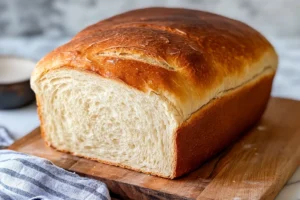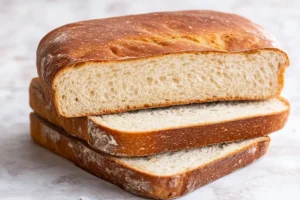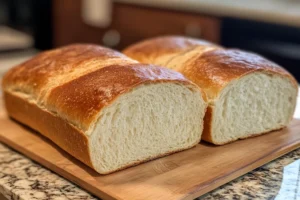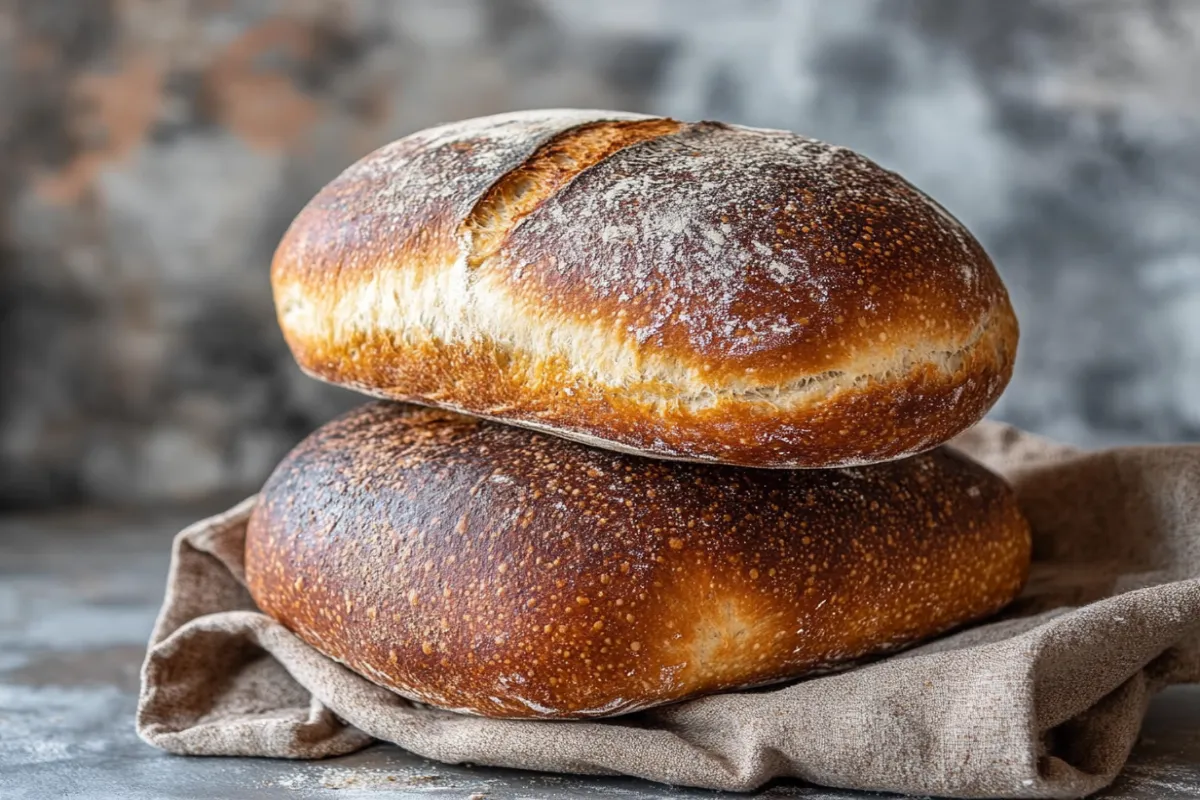Sourdough bread is cherished for its tangy flavor and chewy texture, but one of the most common challenges faced by home bakers is dense sourdough sandwich bread. Baking a light, airy sourdough bread can be tricky, and when things go wrong, the result is often a heavy, compact loaf. In this article, we will cover the reasons why your sourdough may be turning out dense and how you can fix it.
What Makes Sourdough Bread Dense?
Before diving into solutions, let’s explore the potential causes for dense sourdough bread:
- Insufficient gluten development: Bread’s structure relies on well-developed gluten. Without this, the dough cannot trap air, leading to a dense crumb.
- Improper fermentation times: Fermentation affects the rise and airiness of the bread. Under-proofed dough won’t have enough air bubbles, while over-proofed dough collapses under its own weight.
- Inactive starter: If your sourdough starter isn’t active enough, it won’t provide the leavening needed for a light loaf.
- Incorrect hydration levels: Hydration is crucial for sourdough. Too little water makes the dough stiff, while too much water can make it too slack and difficult to shape.
- Under-kneading or over-kneading: Both extremes can negatively impact your dough, leading to dense, flat bread.
The Role of Gluten in Bread Density
One of the most critical factors in preventing dense sourdough is ensuring proper gluten development. Gluten is the protein that provides the structure for bread, allowing it to trap gases produced during fermentation. When gluten is underdeveloped, the dough cannot expand as it should, resulting in a heavy loaf.
Techniques to Promote Gluten Development
- Kneading: Kneading the dough helps develop the gluten. A properly kneaded dough will have a smooth, elastic texture.
- Autolyse: Letting the dough rest before kneading allows the flour to fully hydrate, which promotes better gluten formation. Understanding gluten development is key to achieving the right crumb structure.
- Stretch-and-fold technique: Instead of kneading continuously, you can incorporate the stretch-and-fold method, where the dough is gently stretched and folded at intervals during the bulk fermentation process.
To check if your dough has been kneaded enough, perform the windowpane test: stretch a small piece of dough between your fingers. If the dough stretches thin without tearing, your gluten is well-developed.
The Importance of a Strong Starter
A healthy, active sourdough starter is essential for creating a light loaf of bread. If your starter isn’t bubbly and vigorous, it won’t be able to leaven the dough properly. The result is often a loaf that is dense and under-risen.
How to Maintain a Strong Starter
- Regular feeding: Feed your starter regularly, ensuring it’s active before baking.
- Use the float test: A well-fed starter will float when a small spoonful is dropped into water. If it sinks, it may need more time to develop strength.
- Temperature control: Keep your starter at a warm room temperature (around 70-75°F) for the best activity.
For more tips on keeping your starter strong, refer to this guide on maintaining a healthy sourdough starter.
Hydration Levels: The Key to Light, Airy Bread

The amount of water in your dough significantly impacts the final texture of your bread. In general, higher hydration doughs tend to produce a more open crumb, while lower hydration doughs result in a tighter crumb. However, working with high-hydration doughs requires some skill and practice.
Finding the Right Hydration Level
- Typical hydration: For sourdough, aim for a hydration level between 65% and 75%, depending on the type of flour you’re using and your environment.
- Flour type: Whole grain flours absorb more water than white bread flour, so adjust your hydration levels accordingly.
- Handling high-hydration doughs: High-hydration doughs can be sticky and harder to handle, but they produce a lighter, more open crumb. Using techniques like the stretch-and-fold method can help manage the dough.
For further reading on hydration levels in bread, you can explore hydration tips for different environments at The Perfect Loaf.
Fermentation: Balancing Proofing Times
Fermentation is one of the most critical stages in sourdough baking, and poor fermentation is often to blame for dense bread. If the dough is under-proofed, it won’t have developed enough gas bubbles, resulting in a dense crumb. If it’s over-proofed, the dough may collapse, leading to a flat and heavy loaf.
Understanding Bulk Fermentation and Proofing
- Bulk fermentation: This is the initial rise, where the dough ferments and develops its structure. During this stage, you can perform stretches and folds to strengthen the dough.
- Proofing: After shaping the dough, it needs a final rise before baking. Watch for signs that the dough is ready to bake—such as the dough doubling in size and holding its shape when poked.
Signs of Under-Proofing and Over-Proofing
- Under-proofed dough: The dough will feel tight and won’t expand much during baking, resulting in a dense loaf.
- Over-proofed dough: The dough may collapse and flatten, leading to a gummy, dense texture after baking.
To avoid issues with fermentation, make sure to control the temperature of your environment. Fermentation happens faster in warmer conditions, while cold temperatures slow it down.
Common Baking Mistakes That Lead to Dense Sourdough
Even if your dough is perfectly prepared, mistakes during baking can still lead to dense bread. Here are some of the most common errors that bakers make:
- Incorrect oven temperature: Baking at too low a temperature won’t give your bread the oven spring it needs. Always preheat your oven to at least 450°F (230°C).
- Poor steam generation: Steam is crucial for creating a crisp crust and allowing the bread to expand during the initial baking phase. Use a steam tray or spritz water into the oven during the first 10 minutes of baking.
- Not scoring the dough: Scoring allows the bread to expand in a controlled way. Without scoring, the bread may burst in odd places or fail to rise properly.
How to Fix Dense Sourdough Bread
If you’ve found yourself with dense bread, don’t worry! Here are some steps you can take to troubleshoot and improve your next loaf:

Steps to Improve Bread Texture
- Here are detailed steps to improve the texture of your sourdough bread, helping you achieve a light and airy loaf instead of a dense one.
1. Feed Your Starter Regularly
A healthy sourdough starter is essential for good bread texture. If your starter is weak or inactive, it won’t provide the leavening power needed to produce an airy crumb. To ensure your starter is strong:
- Feed it daily if you’re baking frequently, or at least once a week if stored in the refrigerator.
- Keep the starter at a warm temperature (70-75°F / 21-24°C) for optimal fermentation.
- Look for signs of activity: your starter should double in size within 4-6 hours of feeding and have a bubbly surface.
Perform a float test to check its readiness. Drop a small amount of starter into water. If it floats, it’s ready for use.
2. Adjust Your Kneading Technique
Developing the right amount of gluten is essential for a good bread texture. If the gluten network isn’t developed enough, the dough won’t trap air effectively, resulting in a dense loaf.
- Use the stretch-and-fold technique: Instead of continuous kneading, perform stretches and folds every 30 minutes during bulk fermentation. This method is gentler and helps build the dough’s strength without overworking it.
- Don’t over-knead: Overworking the dough can break down the gluten structure, which will prevent the bread from rising properly. Stop kneading once the dough is smooth and elastic.
Tip: Perform the windowpane test to check for proper gluten development. Stretch a small piece of dough between your fingers. If it stretches thin without tearing, the gluten is well-developed.
3. Increase Hydration
Hydration levels play a significant role in the final texture of sourdough. Higher hydration doughs generally produce a lighter, more open crumb, but they can be trickier to handle.
- Increase water content: Try raising the hydration of your dough slightly. For example, if your current recipe calls for 70% hydration (meaning 70 grams of water for every 100 grams of flour), you could increase it to 72-75%.
- Handle sticky dough properly: High-hydration doughs can be challenging because they are stickier and harder to shape. To work with sticky dough:
- Wet your hands before handling the dough.
- Use a bench scraper to help lift and fold the dough.
- Perform stretch-and-folds during fermentation to build strength without over-kneading.
4. Monitor Proofing Times Carefully
Both under-proofing and over-proofing can lead to dense bread. Under-proofing means the dough hasn’t developed enough gas to create a light crumb, while over-proofing allows the dough to collapse on itself.
- Watch for visual cues: Instead of relying on time alone, look for these signs:
- During bulk fermentation, the dough should roughly double in size.
- When poked, the dough should slowly spring back, but the indentation should remain slightly visible.
- Temperature control: Proofing times can vary depending on the temperature of your kitchen. In warmer environments, dough will proof faster, while cooler temperatures will slow fermentation. Use a proofing box or place your dough in a warm area to control the process better.
If you’re struggling with timing, experiment with a cold proof in the refrigerator. This slows down fermentation and gives the dough more time to develop flavor without over-proofing.
5. Bake with Proper Steam
Steam during the first phase of baking is crucial to ensuring your sourdough bread rises properly and develops a good crust. Without enough steam, the crust will form too quickly, preventing the bread from expanding fully.
- Generate steam: Place a tray with water in the oven, or use a spray bottle to mist the inside of the oven as soon as you put the dough in.
- Use a Dutch oven: Baking your bread in a covered Dutch oven traps moisture from the dough itself, creating a steamy environment. Remove the lid halfway through baking to allow the crust to crisp up.
6. Pre-Shape and Final Shape Correctly
Shaping your dough well is important for maintaining the structure and creating an airy crumb.
- Pre-shape the dough: After bulk fermentation, give the dough a gentle pre-shape to form a loose ball. Let it rest for 10-15 minutes before final shaping.
- Final shaping: When doing the final shape, try to create surface tension by gently stretching the outer layer of dough as you form the loaf. This helps it maintain its shape during proofing and baking.
Tip: If you’re shaping a batard (oval loaf), use the stitching method to create additional tension by folding sections of the dough over one another.
7. Score the Dough Properly
Scoring the dough allows it to expand in a controlled way during baking. If you don’t score it properly, the bread may burst open in unpredictable places or fail to rise adequately.
- Use a sharp blade: Make quick, confident slashes with a lame or a very sharp knife.
- Shallow and deep scores: Make at least one deep score to allow for proper oven spring, and a few shallower ones for decorative purposes.
8. Control Oven Temperature and Timing
Baking your sourdough at the correct temperature is key to achieving a good rise and crust. If your oven is too cool, your bread won’t get the necessary oven spring.
- Preheat the oven: Make sure the oven is thoroughly preheated before placing the dough inside. Bake at around 450°F (230°C) for the best results.
- Adjust oven temperature if necessary: If the bread is browning too quickly, reduce the temperature after the initial 15-20 minutes to prevent burning while allowing the inside to cook fully.
9. Let the Bread Cool Before Slicing
As tempting as it may be to cut into the bread right out of the oven, cooling is an important part of the process. Cutting the bread too early can cause the crumb to be gummy and dense.
- Rest the bread: Allow the loaf to cool completely (at least 1 hour) on a wire rack before slicing. This gives the bread time to set and enhances its texture.
10. Experiment and Keep Notes
Sourdough baking is an art, and even small variations in ingredients, technique, or environment can affect the final product. If you’ve made adjustments but still find your bread too dense, don’t be afraid to experiment further.
- Keep a baking journal: Record each bake’s hydration level, fermentation time, and environmental conditions to track what works best.
- Adjust one variable at a time: When troubleshooting, change only one element (e.g., increasing hydration or adjusting proofing times) per bake to see how it affects the final loaf.
By applying these techniques, you’ll be well on your way to improving the texture of your sourdough bread and achieving a light, airy crumb every time.
Testing New Techniques
Don’t be afraid to experiment with different variables in your sourdough recipe. Slight changes in hydration, fermentation times, and kneading techniques can make a big difference in the final result. Keep notes on your adjustments so you can replicate successes or avoid mistakes in future bakes.
FAQs About Dense Sourdough Bread

Many bakers have similar questions when they encounter dense loaves. Below are some of the most frequently asked questions:
Why Is My Sourdough Sandwich Bread Dense Even Though I Followed the Recipe?
The most common reason for dense bread is improper fermentation. Even if you follow the recipe closely, environmental factors like temperature and humidity can affect how the dough ferments. Always check your dough for signs of proper fermentation, such as doubling in size and feeling airy when poked.
How Do I Know If My Dough Is Over-Proofed?
If your dough is over-proofed, it will feel slack and won’t bounce back when pressed with your finger. Over-proofed dough will also tend to collapse in the oven, leading to a dense, gummy loaf.
How Can I Tell If My Starter Is Ready to Use?
Perform the float test: take a small amount of starter and drop it into water. If it floats, it’s ready to use. If it sinks, it may need more time to ferment.
Can I Still Use Dough That Feels Dense After Shaping?
Yes, but it may result in a denser loaf. If your dough feels dense during shaping, try giving it more time to rise before baking, or adjust your fermentation process in the future.
How Does Temperature Affect Bread Density?
Both the temperature of your dough and the environment in which you’re proofing can significantly affect bread density. In cold temperatures, fermentation slows down, which can lead to under-proofing. In warmer temperatures, fermentation speeds up, which can lead to over-proofing if not carefully monitored.

